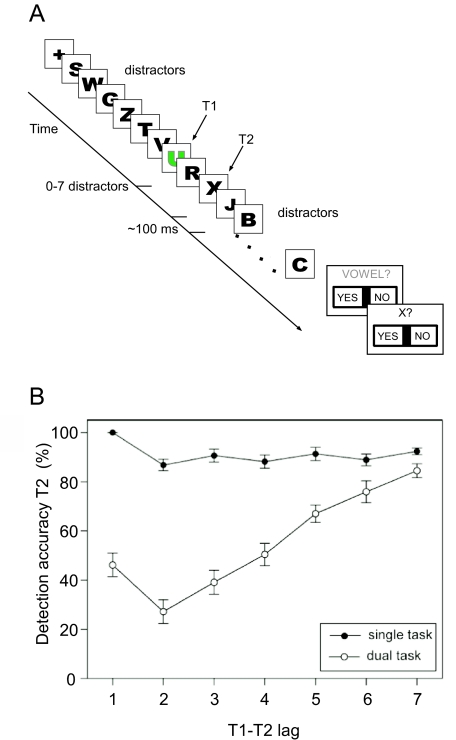Figure 1.
(a) Stimuli and trial structure typically used in an attentional blink (AB) paradigm. A stream of distractor stimuli of variable length is presented before the first target (T1). After the first target (T1) and the second target (T2) more distractors are shown. A trial finishes with non-speeded responses regarding the targets. All stimuli are normally presented at a rate of about 10 per second, resulting in rapid serial visual presentation (RSVP). The critical condition is the dual target task where both targets are task relevant. Typical control conditions include the case where both targets are shown but only T2 is task relevant (single task condition), where the RSVP contains only T1, or where no targets are contained in the RSVRSVRSVP. These conditions help to differentiate between distractor- and target-related brain activity.
(b) Illustration of the behavioural AB effect. The graph shows the mean detection accuracy for the second target (T2) as a function of lag between T1 and T2. A T1-T2 lag of 1 indicates that T2 was the first stimulus after T1, etc. Note that in the single task condition − when T1 can be ignored −T2 performance is very high. The AB is observed when both targets are task relevant, that is, in the dual task condition. T2 performance is particularly impaired for intermediate T1-T2 lags, which corresponds to a time window of about 200 to 500 ms after T1 presentation. The relatively better performance for the shortest T1-T2 lag has become known as T1-sparing. Adapted from “Event-Related Potential Correlates of the Attentional Blink Phenomenon” by C. Kranczioch, S. Debener, and A. Engel, 2003, Brain Research. Cognitive Brain Research, 17(1), pp. 179, 181.

